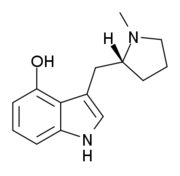Chemistry:4-HO-MPMI
 | |
| Legal status | |
|---|---|
| Legal status | |
| Identifiers | |
| |
| CAS Number | |
| PubChem CID | |
| ChemSpider | |
| UNII | |
| Chemical and physical data | |
| Formula | C14H17N2O |
| Molar mass | 229.303 g·mol−1 |
| 3D model (JSmol) | |
| |
| |
| | |
4-HO-MPMI (also known as 4-Hydroxy-N-methyl-(α,N-trimethylene)-tryptamine or lucigenol) is a tryptamine derivative that is a psychedelic drug. It was developed by the team led by David Nichols from Purdue University in the late 1990s. This compound produces hallucinogen-appropriate responding in animal tests with a similar potency to the amphetamine-derived psychedelic DOI, and has two enantiomers, with only the (R)-enantiomer being active.[1]
The binding affinity for 5-HT2A receptor is 13 ± 2 nM (Ki [125I]DOI). It is reported at doses starting at 0.5 mg and 1.0-1.5 mg seem to be psychedelic doses. The duration it is reported between six and eight hours. The effects, still not too documented, are OEV/CEV, sedation and anxiety.[2][unreliable source?]
See also
- 4-HO-pyr-T
- 4-HO-McPeT
- 5F-MPMI
- 5-MeO-MPMI
- 5-MeO-pyr-T
- CP-135,807
- MPMI
- SN-22
References
- ↑ "Further studies on oxygenated tryptamines with LSD-like activity incorporating a chiral pyrrolidine moiety into the side chain". Journal of Medicinal Chemistry 42 (20): 4257–4263. 1999. doi:10.1021/jm990325u. PMID 10514296.
- ↑ "Lucigenol Info - Hip Forums". http://www.hipforums.com/newforums/showthread.php?t=315326.
 |

